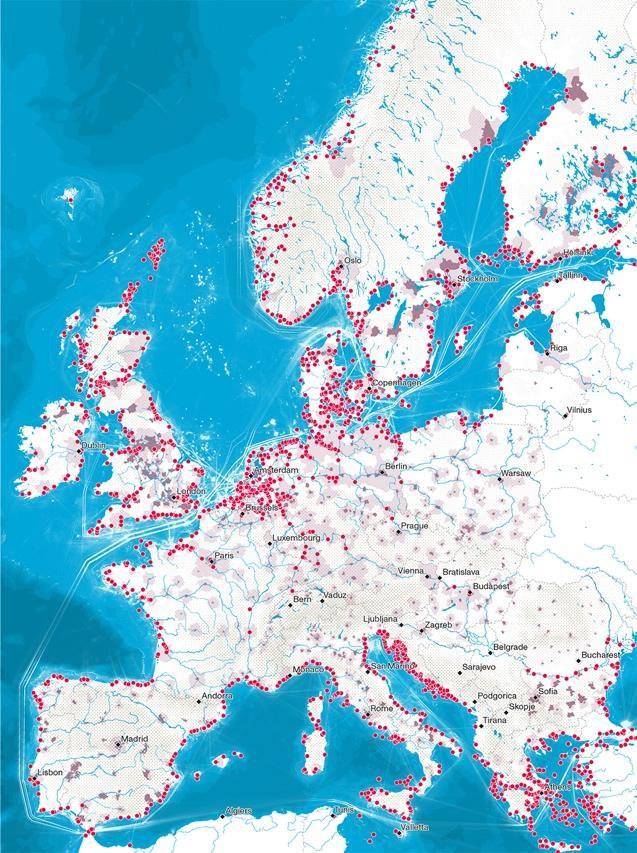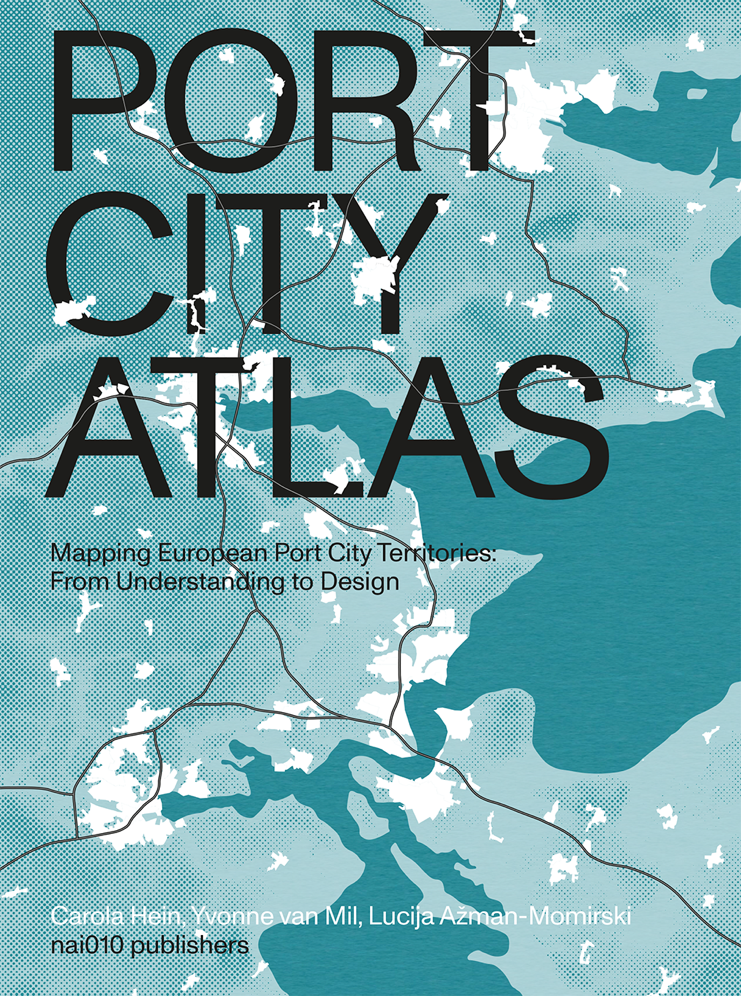Carola Hein, Yvonne van Mil, Lucija Ažman-Momirski
Understanding the unique spaces of port city territories, where global flows meet local geographies, topographies, histories and practices, requires a unified approach to visualisation, specifically mapping a large number of territories in a unified way. Such an approach can help us to understand the relationships between sea and land, and between port, city and territory. It also helps us to examine the relationship between multiple port city territories as part of international trade networks and can facilitate the identification of 'gaps' (Hein & Van Mil 2020) where spatial, institutional or cultural opportunities and challenges exist, and where planning can be of a benefit. With the publication of the Port City Atlas, we introduce a new conceptual and methodological approach to international comparative research that bridges different disciplines and fields, and which serves as a catalyst for new scientific and professional explorations of the impact of ports on cities and territories.

Looking at port city territories from the perspective of the sea
Europe is a continent surrounded by water on three sides, with major seaports and metropolises along its coasts. Public and private responses to current crises such as climate change, rising sea levels and migration depend on coordinated approaches along Europe's coasts. Yet Europe's maritime borders are rarely recognised as part of European policymaking and identity formation. The internal focus on nation states, national borders and European unification has distracted policy makers and stakeholders from a maritime perspective of the continent. However, looking from sea to land, we can recognise seaports and their unique role in shaping Europe's future. Moreover, we can consider the port and its adjacent port city, the marine foreland and the terrestrial hinterland as a distinct type of space: the port city territory.
With the Port City Atlas, we highlight these territories as key actors, key locations and potential stewards of the future of water. In doing so, we use a sea-based approach that considers water as a key link between ports, cities and surrounding territories, for human life and for navigation - overcoming traditional land-based approaches that depend on national borders. This perspective helps us bridge national differences and opens up a crucial new opportunity to address today's challenges of the climate crisis, the energy transition, migration and numerous water-related emergencies, and to address today's challenges at the land-sea interface in a coordinated way. However, this perspective also shows that stakeholders in these territories are diverse and numerous, that there is a lack of governance at the territorial level, a lack of methodologies to fully understand these territories, and that the important impacts of ports on territorial development are not yet fully understood.
Mapping as a tool for the study of port city territories
Conceptualising contemporary port city territory - its form, governance and culture - as unique and developing methods to visualise the multiple flows, institutions and practices that occur in these territories is the first step in our new methodological approach to understanding and planning coastal areas. In the Port City Atlas, we argue that visualising quantitative and qualitative data in maps and infographics can provide a basis for comparative analysis that goes beyond case study approaches, which are often embedded into national contexts, selected languages or monodisciplinary approaches (Hein & Van Mil 2019). Accordingly, a comprehensive (geo)spatial mapping approach enables the exploration of a single port city territory as part of a larger system of maritime and transport connections, as well as standardised comparisons between territories. In addition, mapping can serve as a so-called 'gap finder' - a tool to identify transitional territories that often cross institutional boundaries without strong, mutually supportive governance frameworks, legal systems and planning policies.
To study European port city territories in the light of their global, national and local contexts, we have used a multi-scale approach and defined three levels of spatial interest: Europe, the four maritime waters of the European continent and the port city territory. The European scale means that all port cities are part of the same overarching political entity, with corresponding legislation, regulation and a common European history. Maps at this scale show how the port city territories are connected by water and land, and how they relate to each other, their geographical, topographical and political context, and the European trade network (using data on global shipping routes and other sea-based networks, digital elevation models, population densities and inland transport links). At the same time, nations are very diverse, and their borders have changed over time. By adding a second scale and exploring the port city territories within and between the four waters surrounding Europe - the Baltic Sea, the North Sea, the North Atlantic Ocean and the Mediterranean Sea - we have identified particular constellations and conditions, such as natural geographical conditions (through coastal morphology and bathymetry data), cultural and political settings, and their position in maritime networks, which are different for each body of water. The third - and most prominent - scale in the atlas is the port city territory, which captures the spatial relationship between the port, the adjacent city and the surrounding landscape, as well as their geographical location and urban patterns, transport networks and institutional boundaries.
The atlas visualises the port city territory through the spatial extent of the port itself, the built-up area in and around the port, the infrastructure and the hinterland, with references to health, education and governance institutions. To map 100 port city territories, we used open access data from the European Commission and chose a scale that is independent of institutional boundaries and can cover a larger area. We have chosen to map these areas at the same scale, using both morphological and functional aspects to highlight their common typology while exploring the unique needs and opportunities of each area. Each map is accompanied by an infographic page with data on the water-land intersection, detailed information on the port (e.g. data on vessels, port functions, number of passengers, types of cargo), information on the port city (e.g. percentage of built-up area, industrial area, port area, number of people living in the area) and information on the port city territory (e.g. geography, demography).
Selecting 100 leading seaport city territories
In selecting the top 100 seaport city territories, we considered ports as key factors in the movement of people and goods from sea to land and from land to sea. Based on maritime flows, we first identified the leading ports using Eurostat maritime statistics and then looked at neighbouring city or cities of each port and port city territory. In order to identify the leading port city territories, we ranked the top 25 ports for each of the four maritime waters based on port functions (cargo and passenger ports). Taking into account the total gross weight of cargo and the total number of passengers in combination with the number of people living in the neighbouring territory, based on population figures of the Eurostat NUTS3 regions, we selected the leading 100 European ports, 25 per sea. This group includes major port cities such as Rotterdam, Hamburg and Marseille, but also smaller ones such as the Finnish oil port of Sköldvik or the transhipment hub of Puttgarden. We have also included some ports that do not meet these criteria, such as Bordeaux and Oslo. We have included them because they are important historical and cultural port cities that have adapted to the transit of goods and passengers over decades, sometimes centuries. Although they have recently lost part of their port function and cannot compete with modern industrial ports, their urban structure, infrastructure and architecture are still based on this (former) port function and they face similar future challenges as other port cities, such as the redevelopment of former industrial port areas.
Comparing 100 seaport city territories
The Port City Atlas maps and presents 100 European port city territories in a comparative and uniform manner so that their water-land interfaces can be identified, compared and studied. The maps with selected ports, adjacent cities, port city territories, integrating their maritime and land parts, and infographics illustrating key geographic, port, port city and port territory data provide the basis for re-conceptualising the water and land of European port city territories, both in academic research and in future development and planning. Using the Port City Atlas, port authorities, city governments and other actors will be better equipped to negotiate and address many contemporary challenges, including the climate crisis and challenges in the contact areas between ports and their surroundings. The enabled comparisons also offer opportunities to find and develop innovative urban planning solutions (Ažman 2010), including balanced and sustainable development.
Designed as a reference work, the Port City Atlas offers a new perspective on port cities and is the first volume in a series of maps of port territories. A second volume will explore the social, environmental and spatial relationships in port city territories along rivers and canals that provide important links inland. As a next step, this methodology can be used as a basis for exploring how historical events have shaped contemporary development patterns in different port city territories; and for developing collaborative approaches to support ports that serve nearby territories as well as distant forelands and hinterlands through citizens’ engagements.

The new book Port City Atlas. Mapping European Port City Territories: From Understanding to Design by Carola Hein, Yvonne van Mil and Lucija Ažman-Momirski is out now through NAi010 Publishers: https://www.nai010.com/en/publicaties/port-city-atlas/246049/
Acknowledgement
The authors wish to thank the mapping team who helped set up the Port City Atlas: Stephan Hauser, Lukas Höller, Douwe de Jager, Hülya Lasch, Yvonne van Mil, Batuhan Özaltun, Myrthe Peet, Mees van Rhijn; and Vincent Baptist for editing the blog text.
